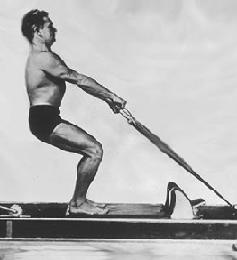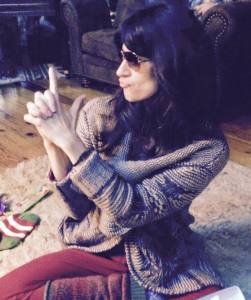Posts
Ep 36: Our changing industry – Do we fear or embrace change?
/0 Comments/in Thinking Pilates /by ChantillPodcast: Play in new window | Download
Subscribe: Apple Podcasts | RSS
I’m excited to share this podcast with you for a couple of reasons. One, Melissa Kakavas and I met and connected several years ago while in the Balanced Body faculty training. We were thrust together spontaneously to make some videos for their enthusiasts collection, but had never even met. It’s not all that often that you meet someone and you instantly feel like “I get you.” Making videos is not easy, period, but trying to make videos WITH someone you’ve never met is, well…close to delusional. Somehow we just jived and that was that. Since then, we’ve developed a special kindred friendship.
The second reason is because there is a really sweet, and unexpected, connection we make toward the end of the podcast that is going to set you up for the release of episode 37 with Debora Kolwey where we talk about the mind’s habit to compare; the need to see things as black or white, right or wrong, better or worse. This is an important idea and really relevant to the teaching environment. I think you’re going to enjoy the flow from this conversation to the next.
And, there is a third reason, and that’s because the foundation of our conversation (although we don’t get to it for a while) is all about values. In the Skillful Teaching cohort we talk about values as Core Commitments, which is a term I stole from meditation teacher and author Sally Kempton. But no matter what you call them your values, what you’re most committed to is the river you’re floating in. And that river is not only ever-flowing, but it is also ever-changing. It is also the thing that can set you apart, help you stand out, carve out a niche, but above all else it’s literally what buoyies you to a good life worth living. Not an endlessly happy and perfect life, but a good life, one in which you can navigate all the suffering, changes, and ups and downs and still say I’ve grown a lot, learned a lot, and loved a lot.
I don’t want to draw this out too much longer, but I will say that I’ve also been titillated lately by a new book (many of you know I’m a total bibliophile), called “The Subtle Art of Not Giving a F*ck” by Mark Manson, which is all about giving a fuck; it’s all about values. It’s not only super funny, it’s also pretty right on when it comes to why we struggle so much in life and how we might struggle less if we just decided what we value.
This is a lengthy conversation, but well worth it especially if you find yourself struggling with how to navigate the challenges of our industry growing by leaps and bounds and deciphering a way to not only stand out and stay afloat, but stay true to your passion and reasons for teaching.
Enjoy!
About Melissa Kakavas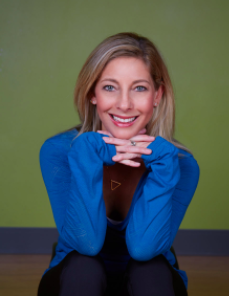
Melissa Kakavas is the Director of Pilates Education and Programming at EVOLVE Movement in Raleigh, North Carolina. She is also a master instructor for Balanced Body and has been teaching and mentoring teachers for the past ten years. Melissa originally found Pilates in the early 90s while living in New York City and has been practicing and teaching ever since. She also teaches Gyrotonic, Gyrokinesis, and practices Thai Yoga Body Therapy. Melissa”s teaching style is warm and energetic, inspiring a healthy understanding of the body, and a strong passion for movement.
Upcoming Workshop w/ Chantill at EVOLVE Movement
- Saturday, April 29th – Fearless Extension
- Sunday, April 30th – Scoliosis & Osteoporosis Unraveled
For all the details: http://www.evolvemovement.com/events-workshops
Sans Heroes and Pro Tips
This podcast was a bit of an impromptu project, so we’re keeping it low key. We’re forgoing the Heroes and Pro Tips elements of the podcast this time around, but did want to share a few things we mentioned in the podcast with you.
Links and Resources
- The Psychology Podcast with Doctor Scott Barry Kaufmann (were I first learned about Mark Manson. *Caveat: The Psychology Podcast is mediocre but the guests SBK has on his show are almost ALWAYS interesting. A few of my favorites have been:
- “The Subtle Art of Not Giving a F*ck” by Mark Manson
- Exploring Core Commitments:
- Go Your Own Way by Sally Kempton
- Core Commitments: A Personal Inquiry Into Teaching by Chantill Lopez
- The 4 Most Pivotal Teaching Tools For Enhancing Motivation in our Pilates Students and Ourselves
- Part 2 – The 4 Most Pivotal Teaching Tools For Enhancing Motivation in our Pilates Students and Ourselves
Connect With Us
- Email us at thinkingpilatespodcast@gmail.com or use the form below.
- Find us on Facebook at The Thinking Pilates Podcast
Reach us Individually
- Chantill – chantill@skillfulteaching.com
- Phone – (707) 738-7951
- Debora – dkolwey@gmail.com
Thinking Pilates Podcast - Connect with Us
Ep 33: How to break the rules – When questioning is the answer.
/0 Comments/in Thinking Pilates /by ChantillPodcast: Play in new window | Download
Subscribe: Apple Podcasts | RSS
Today we proudly bring you episode 33 staring one of our new co-hosts, mentor and teacher, 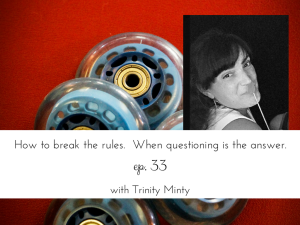 Trinity Minty. Even though we are technically one third of the way to 100 it somehow feels like this is still only our second episode. We’ve gotten so much wonderful feedback as a response to our new and improved production and to the additional elements, that I’m having that same giddy feeling as when we first launched.
Trinity Minty. Even though we are technically one third of the way to 100 it somehow feels like this is still only our second episode. We’ve gotten so much wonderful feedback as a response to our new and improved production and to the additional elements, that I’m having that same giddy feeling as when we first launched.
I’m particularly excited about today’s podcast because not only do we get to be a part of an interesting discussion that challenges the way we think about some of what teach — it’s all about questioning and not taking things at face value — , we’re also going to witness something that, for me, is truly tremendous, something that deeply reflects the why of what I do…
Heroes
As the co-host of today’s show, I asked Trinity to choose who or what she wanted to share with you in this section and her answer was so totally perfect, but not at all where my head was. Her answer was a group of courageous and sincere teachers that are taking big risks and making big changes. To hear Trinity talk about the teachers currently participating in the Skillful Teaching 28-Day Fulfilled & Successful Pilates Teacher online course:
Listen to the podcast at around minute 52:00.
Another hero I thought you’d all enjoy, which in some way totally plays into being able to seek out your own answers and be authentic, is infamous TED Talk presenter and social psychologist Amy Cuddy and her new book “Presence.”
“Presence” is straightforward and insightful, although not entirely astonishing if you’re a movement teacher. What I’ve loved most about the book is learning about the plethora of research that is proving how the state of our body informs and influences, changes even, our sense of self, security, power, confidence, and how in turn these things help us face our most challenging moments.
Here’s a short excerpt I thought might entice you:
“The way you carry yourself is a source of personal power — the kind of power that is the key to presence. It’s the key that allows you to unlock yourself — your abilities, your creativity, your courage, and even your generosity. It doesn’t give you skills or talents you don’t have; it helps you to share the ones you do have. It doesn’t make you smarter or better informed; it makes you more resilient and open. It doesn’t change who you are; it allows you to be who you are.”
Pro Tip
Because we wanted to encourage you to explore the idea of questioning after the show, our Pro Tip for this episode looks at how you might change your perspective on one of our most loved and loathed Pilates exercises…(of course you know what I’m talking about, I can practically hear you all saying it from here)…the 100!
Here are our suggestions:
From the starting position, lift and lengthen out reaching the arms long, collarbones wide. Begin pumping the arms, inhaling for a count of five, exhaling for a count of five. With your exhalation, can you curl up a little higher?
The above is a typical way you’d hear the 100s being taught.
What if we simply omitted the cue of reaching the arms and collarbones wide and instead focused on creating spinal flexion that is deeply supported from the back body, which has the potential to relieve some tension in the throat and shoulders and improve breath?
Something like:
When you begin to lengthen the legs out, soften the sternum downward and draw the ribs into the body, curling up from that initiation point. Allow the arms to lengthen and begin your pumps. The arm pumping works in a way that gets the circulation working.
What you may see when cueing with this focus is the ribs moving toward the back body in a way that lends to the appearance of the collarbones narrowing. However, how does the abdominal curl itself look? Does the spine look fully supported in flexion? For me, coming into spinal flexion from supine with a strong cueing of the arms long and collarbones wides, feel like I am working against myself.
Also consider starting the 100 not from supine, which requires so much more of the body and not always in a good way, and come into the position from sitting or balance point, then rolling back, gradually coming into the position with your shoulder blades and ribs completely off the mat (this is reminiscent of a more classical position for hundreds – in a deep imprint). Explore whether or not the flexed position feels more supported from the back of the hips, legs, and spinal extensors and whether or not you still feel like you’re hanging off the front body, the neck especially, in an effort to fight the tireless pull of gravity?
Our experience is that this way of working into the 100 helps people find greater joy and value in the exercise and motivates them to work at it.
We’d absolutely love to hear what you think about this.
Links and Resources
- 3 Most Dangerous Cues webinar:
- Fearless Teaching article
- Trinity’s blog post called Discernment and Integration
- Thinking Pilates Podcast Ep. 26: From mimicry to original thought…How does it happen?
- Thinking Pilates Podcast Ep. 27: When change hits the fan…discerning in the big picture.
Connect With Us
- Email us at thinkingpilatespodcast@gmail.com or use the form below.
- Find us on Facebook at The Thinking Pilates Podcast
Reach us Individually
- Chantill – chantill@skillfulteaching.com
- Phone – (707) 738-7951
- Debora – dkolwey@gmail.com
Thinking Pilates Podcast - Connect with Us
Ep 32: The Absolutely fabulous women of Primal Movement WORKS
/1 Comment/in Thinking Pilates /by ChantillPodcast: Play in new window | Download
Subscribe: Apple Podcasts | RSS
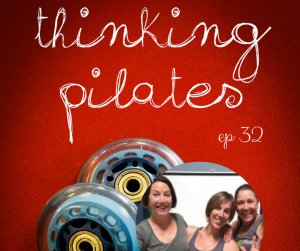 Join me in this fantastic interview with the talented, funny, and successful band of mighty misfits, the founders of Absolute Center in Lafayette, CA: Claudia Moose, Katie Santos, and Louise Johns.
Join me in this fantastic interview with the talented, funny, and successful band of mighty misfits, the founders of Absolute Center in Lafayette, CA: Claudia Moose, Katie Santos, and Louise Johns.
In this episode you’re going to get a lot of laughs (that’s I think par for the course with us), get a ton of great insight into how to make business partnerships not only work, but thrive and discover more about the origins of Primal Movement Works and their upcoming teacher training.
You may have heard Claudia on our last podcast “Live from the PMA”. If you did, then you know that you’re in for a treat. If not, let’s not waste any more time…
Below you’ll find two of our cool new podcast elements: Heroes and Pro tips. We hope you love these new additions and they bring a little more value to your teaching.
Heroes
First on our list is one of Claudia’s favorite books:
- The Well Balanced Child: Movement and Early Learning by Sally Goddard Blythe
And if you haven’t checked out what osteopath and acupuncturist Phillip Beach is doing, we highly recommend you investigate his book:
Not only does the Primal Movement Works training program draw from Beach’s work, his archetypal postures and erectorcises are making a huge impact in the Pilates community as we look beyond fixed structure and predetermined movement to something that’s more resilient and truly human.
Our final “hero” is a little self-serving but also deeply in the service of moving our professional industry into the digital health arena. If you’re a regular listener you heard me interview Pilates Metrics founder, Joseph Quinn in Episode 29.
Pilates Metrics is an outstanding and powerful new cloud-based ipad app that is ultimately helping Pilates become more credible and viable as a proven tool for injury prevention and rehabilitation. What it does for you is help you plan, program, track and assess digitally, which provides more concrete data and more motivation for you and the student to stay the course, adapt, build and progress through the Pilates work.
The app itself is incredibly malleable allowing you to choose from 9 or 10 exercise libraries to work from. The libraries provide a technical and philosophical platform from which you teach. Some of them are based solely on a school’s training curriculum like Polestar and Fletcher Pilates. Others, like the one Skillful Teaching created, is based on a teaching philosophy.
The heart and soul of the Skillful Teaching library is a WHOLE PERSON TEACHING approach.
Pro Tip
Given all of that, our pro-tip for this episode is Keep it Simple and Let it go. Let go of form and explore what movement potential exists in the body as it is. See if you can find ways to open the body up to it’s own current potential rather than being so focused on what movement should look like. One way I’ve found to do this, working with the spirals of the feet in foot work is to deliberately work off center and to move through the varying angles and positions of the foot as the load of the springs oscillates and progresses. Watch how your student adapts, where they’re compensating in the knees, pelvis, low back and shoulders.
The caveat is that you work on a relatively light spring (1R, 1B to 2R) and the body you’re working with doesn’t have any acute foot, ankle, knee or hip issues. Keep your students safe, of course, but let them see how their bodies can move out of alignment. I think what you’ll find is that they have way more potential than you thought.
I’d love to know how that goes.
Links and Resources
- Absolute Center
- Primal Movement Works
- Primal Pilates FB page
- Skillful Teaching Pilates Metrics Library
- Pilates Metrics
Upcoming Primal Movement WORKS Training:
- Primal Foundations
- January 28th & 29th
- Register HERE
Connect With Us
- Email us at thinkingpilatespodcast@gmail.com or use the form below.
- Find us on Facebook at The Thinking Pilates Podcast
Reach us Individually
- Chantill – chantill@skillfulteaching.com
- Phone – (707) 738-7951
- Debora – dkolwey@gmail.com
Thinking Pilates Podcast - Connect with Us
Pilates Origins Workshop
/0 Comments/in Blog, Featured /by ChantillPilates Origins Workshop with Chantill Lopez
One teacher’s perspective on what Pilates is, was meant to be, and can be…
SPECIAL ANNOUNCEMENT: The Fulfilled & Successful Teacher 28-Day Online Workshop starts Jan. 18th. Sign up this week (Jan. 5th-9th ONLY) and receive $250 Bonus Gift! Click HERE!
My first meeting with classical Pilates was a little bit like shaking hands with someone whose grip is just a bit too strong. I admired the boldness and confidence, but interpreted the forcefulness as narrow and limiting.
As an emerging teacher I knew myself well enough to see that my path lie in cultivating a practice that was more malleable and creative, with more options for insight and intuition — or that is what I thought I was doing.
I’ve come a long way since then and have completed the orbit — this one at least — and there is a very beautiful thing that happens when you reach this place.
In this moment there is a pause where you see connections, have a well-earned ounce of clarity, openness, and ease.
What ever you imagined you knew, you realize you may never know, and yet there is a sense of understanding and appreciation that only comes from immersion and experience. You can see from both directions. We come to these places about all kinds of things, and throughout our lives. It’s a super cool place.
In the Pilates Origins Workshop, a portion of which you are about to watch and/or listen to…
THIS IS MY GOAL: To open up the discussion without a classic or contemporary agenda; to offer teachers an opportunity to discern for themselves what it is they are teaching, how it translates into their current understanding and beliefs, and how they might more fully invest themselves in the authenticity of the method they love.
My teacher and mentor, Carol Appel, started me on this path and more recently Amy Taylor Alpers has helped me complete a part of it — understanding the philosophy and crafting a strong point of view around it. I mention this concept quite a bit in the workshop and am grateful to the interview in which Amy first shared it with me. (Listen to the interview here).
Having a strong point of view and knowing WHY we teach is crucial to our own internal satisfaction and sense of service, not to mention for strengthening the practice we help our students cultivate.
AND our point of view can be open and kind and inclusive. Having a strong point of view doesn’t mean — to me — belittling another approach, or perpetuating the belief that my point of view is better or the only “true” perspective.
Intelligence and wisdom are both manifested by willingness:
willingness to be stretched, to be wrong, to be swayed, to listen, and most of all the willingness to discern.
That is what the Pilates Origins workshop is really about. It’s about not only translating Joseph’s writings and in turn better understanding what the method was originally designed to be, but a chance to be stretched, to listen, to question, and to see what point of view feels right for each of us.
I very much hope you enjoy the recordings. You may hate what I have to say, you may respond very strongly to my comments and interpretations OR you may love it and love me (wink, wink). Either way, I applaud you for your passion and hope that in some small way the discussion gets your juices flowing, your heart pumping, and your inspiration bubbling.
I’m open to questions and comments (only nice ones though) below. Enjoy, share and Happy New Year!
With gratitude and joy,
Chantill
P.S. A reminder to never take ourselves too seriously!
Audio and Video Files (2 Hours Total)
Audio Part 1
Audio Part 2
Pilates Origins Workshop Part 2 from Skillful Teaching on Vimeo.
Pilates Origins Workshop Part 1 from Skillful Teaching on Vimeo.
The Greatest Love Letter You’ll Ever Write…is to yourself
/0 Comments/in Blog, Featured /by ChantillA Love Letter Like No Other
Dearest Friend,
I am often surprised at how long we’ve known each other; sometimes it feels like moments. And yet other times it feels like multiple lifetimes. When I think of our friendship I realize that I have rarely let other people know me in the way that you know me – all of the potential for beauty and brilliance and absolute darkness. This gives me such a sense of relief and I feel myself soften into being just who I am without any walls, defenses or excuses…and for that I am grateful.
I am grateful for your tenderness, your unconditional willingness to love those parts of me that I most want to hide from the rest of the world – my tendency to be mean and judgmental, intolerant, and impatient. You always smile at me and for me; to let me know – I think – that it’s okay, that those things are not the whole of who I am and that it is possible for all of who I am to be enough.
I have perhaps never told you how beautiful I think you are, how sweet and vulnerable, and yet so strong and steady. You have the ability to take action with a clarity and decisiveness that I both admire and wish I had myself. And yet just being around you I am reminded that I can be these things too. I watch, listen, and feel how it is possible to be malleable, open, deliberate and dedicated. You have that much brightness — it would be hard not to be affected by your presence.
There is also a generosity in you that runs deeper than I can fathom. We laugh at how you like to be the center of attention, have people wait on you, and your uncanny ability to inspire others to support your efforts and still I can see further to the truth: that what you really want is for others to be loved, cared for, seen, nurtured, affected and changed so that they might live fuller lives. No matter how often you try to convince me to do things this way or that, I never cease to feel that you love me and want me to trust myself above all else.
And so I am writing you this letter today as a way of peeling back another layer of protection from my heart and quite possibly knowing myself more honestly than ever before.
Thank you for your voice, your insecurity, your intelligence, your guidance, your trust, and your love. May every day bring you joy and may that joy be reflected in the hearts of all you meet you. I cannot imagine it could be otherwise.
With more sincerity than I sometimes say it,
I love you.
Postscript
The preceding love letter I wrote as a reminder that nothing can exist in my view unless I possess it myself; that when I see any quality in others IT PROVES the existence of that same quality in me for I CAN ONLY EVER REFLECT what I already have – whether I am willing or ready to see it or not (that’s perhaps the major kicker.)Thanks to my dearest friend, cohort, co-teacher and co-creator Cori Martinez I wrote this love letter to rediscover myself through my own eyes and hers.Can I believe that each characteristic, ability, personality trait, and quality that is contained within the letter above is in me? Is in fact a reflection of me? Can I know it as truth?*An exercise you might consider trying out ;)*
A Note On Seeking Approval, Building Confidence From The Outside In
Howdy
 How are you showing up? Why are you showing up? Why do you teach? What IS teaching? Why do you care? This is Skillful Teaching: A Whole-person approach to being an expert teacher, not an expert technician. There's a difference. Want to know what it is?
How are you showing up? Why are you showing up? Why do you teach? What IS teaching? Why do you care? This is Skillful Teaching: A Whole-person approach to being an expert teacher, not an expert technician. There's a difference. Want to know what it is?Resources For Right Now
The Power of Mentoring
Archive
- November 2021
- June 2020
- April 2020
- March 2020
- September 2019
- June 2019
- February 2018
- December 2017
- November 2017
- September 2017
- August 2017
- July 2017
- June 2017
- May 2017
- April 2017
- March 2017
- February 2017
- January 2017
- October 2016
- July 2016
- June 2016
- April 2016
- January 2016
- November 2015
- October 2015
- September 2015
- August 2015
- June 2015
- March 2015
- February 2015
- January 2015
- December 2014
- October 2014
- September 2014
- August 2014
- July 2014
- May 2014
- April 2014
- February 2014
- January 2014
- December 2013
- November 2013
- October 2013
- September 2013
- August 2013
- July 2013
- June 2013
- May 2013
- April 2013
- February 2013
- January 2013
- December 2012
- September 2012
- July 2012
- May 2012
- April 2012
- March 2012
- February 2012
- January 2012
- December 2011
- November 2011
- October 2011
- September 2011
- July 2011

